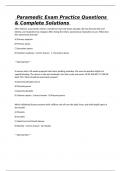Paramedic Exam Practice Questions
& Complete Solutions
After delivery, a paramedic notices a newborns heart rate drops abruptly, skin has become blue and
blotchy, and respiration has stopped. After drying the infant, spontaneous respiration occurs. What does
this assessment describe?
A) Primary asphyxia
B) Primary apnea
C) Secondary apnea
D) Newborn asphyxia - Correct Answer C. Secondary apnea
**ON THE TEST**
A woman who is 38 weeks pregnant had minor spotting yesterday. She now has painless bright red
vaginal bleeding. The uterus is soft and nontender. Her skin is pale and moist. VS BP 100/60 P 112 RR 28
Spo2 95%. What should the paramedic suspect?
A) placental abruptio previa
B) Placenta previa
C) placenta abruptio
D) Uterine rupture - Correct Answer B) Placenta previa
Which childhood disease presents with a diffuse rash all over the body, fever, and white koplik spots in
the mouth?
A) Measles
B) Varciella
C) Hand-Foot and Mouth disease
D) Rubella - Correct Answer A) Measles
**ON THE TEST**
,Which of these would suppress the compensatory mechanism of tachycardia and a geriatric patient who
is experiencing hemorrhagic shock?
A. Thiazide diuretics
B. Beta blockers
C. Calcium channel blockers
D. Blood thinners - Correct Answer B. Beta blockers
What is the correct amount of fluid to a minister to a five week old infant who weighs 8 pounds with
significant dehydration?
A. 36 mL
B. 72 mL
C. 82 mL
D. 160 mL - Correct Answer B. 72mL
Which of these is most likely NOT to be sustained from the tertiary phase of blast injuries?
A. Compression fractures of the spine
B. Rib fractures
C. Hyperextension injuries
D. Pulmonary barotrauma - Correct Answer D. Pulmonary barotrauma
**ON THE TEST**
Which of these is most likely to be sustained from the tertiary phase of blast injuries?
A) Smoke or toxic fume inhalation, burns, crush injuries
B) Lacerations, eye injuries, extremity fractures
C) Compression fractures of the spine, rib fractures, hyperextension injuries
D) Tympanic membrane rupture, headache, blast lung injury - Correct Answer C) Compression fractures
of the spine, rib fractures, hyperextension injuries
What should a paramedic do when confronted with a prolasped cord?
,A) Place gloved fingers between the baby and the mothers pelvic bone
B) Insert gloved hand into the birth canal in order to restrain delivery
C) Attempt to push the cord back into the birth canal
D) Clamp and cut the cord and instruct the mother to push as hard as possible - Correct Answer A)
Place gloved fingers between the baby and the mothers pelvic bone
A 20-year-old has been working in the sun for the past six hours on a very hot day and c/o extreme
dizziness, weakness, thirst, nausea, and has vomited x2. Skin is warm, flushed, diaphoretic. VS: BP 94/60
orthostatic changes; P 118 and thready; spo2 97%; T 99F. Glucose 120. What should the paramedic
initiate for the patient?
A) IV NS in consecutive 200 mL increments
B) Cover with a cold wet shet
C) Give 32 ounces of electrolyte solution orally
D) Transport patient as quickly as possible - Correct Answer A. IV NS in consecutive 200 mL increments
**ON THE TEST**
Which of these is appropriate treatment for hyperemesis gravidarum?
A) EKG monitoring for irregularities
B) Cesarean section
C) Benzodiazepine administration
D) IV fluid replacement - Correct Answer D) IV fluid replacement
A 28-year-old patient presents with an acute onset of shortness of breath, Hives, and itching on the face,
neck, and palms following dinner. The pt has edema of the lips, tongue, and eyelids, facial flushing, and
stridorous respirations. She is anxious, light headed, and struggling to breath. VS BP 86/palp, RR 48, P
128, spo2 82% on room air.breath sounds are bilaterally diminished. Which medication should a
paramedic get first?
A. Epinephrine 1:10 IVP
B. Epinephrine 1:1 IVP
C. Benadryl 50mg IVP
D. Benadryl 25mg IVP - Correct Answer A. Epinephrine 1:10 IVP
, Which drug should a paramedic administer first to a patient experiencing a systemic allergic reaction
with facial edema, tearing, generalized hives, severe dyspnea and wheezing, palpable radial pulse and BP
130/80?
A. Benadryl
B. Epinephrine
C. Lidocaine
D. Midazolam - Correct Answer B. Epinephrine
Which drug should a paramedic administer first to a patient experiencing a systemic allergic reaction
with facial edema, tearing, generalized hives, severe dyspnea and wheezing, palpable radial pulse and BP
130/80?
A) Benadryl
B) Solu-Medrol
C) Albuterol
D) Epinephrine - Correct Answer D) Epinephrine
What special care is needed to transport a patient who receives kidney dialysis every three days?
A. Keep the patient in a lateral recumbent position during transport.
B. Keep the arm with the fistula elevated above the level of the kidneys.
C. Dialysis patients require careful titration of IV fluids.
D. Dialysis patients generally require large amounts of IV fluids. - Correct Answer C. dialysis patients
require careful titration of IV fluids
What is the purpose of placing the patient in a neutral (in-line) position during spinal immobilization?
A) To facilitate the placement of head blocks
B) For easier airway access
C) To prevent the tongue from falling to the side of the airway
D) To allow the most space for the spinal cord within the column - Correct Answer D) To allow the most
space for the spinal cord within the column




